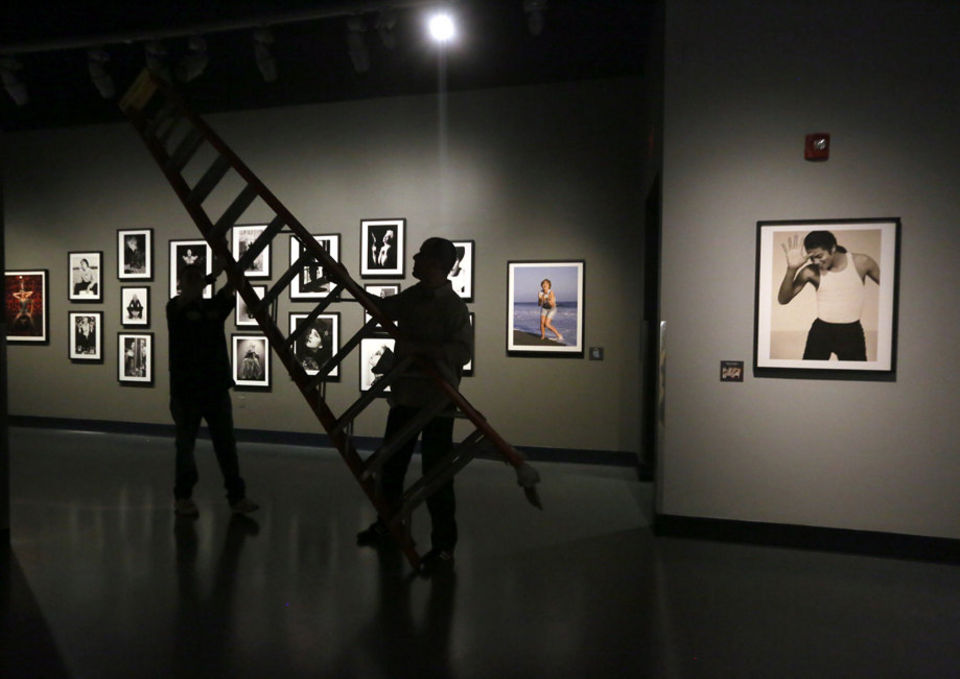LEVELAND, Ohio – Biographers take volumes — and in some cases, multiple volumes — to tell a life story. Herb Ritts could do it with a single image.
The work of Ritts, who started his professional life as a still photographer and reluctantly segued into a music director before his death from complications of AIDS in 2002, is the subject of an exhibit at the Rock and Roll Hall of Fame and Museum, “Herb Ritts: The Rock Portraits,” which opens Friday, March 13.
The exhibit, which takes up multiple floors on the upper levels of the Rock Hall and includes multimedia stations and video as well photos and artifacts, truly is one of the best in recent memory at the I.M. Pei structure on the shores of Lake Erie.
The Ritts quote that opens the exhibit puts it into a nutshell:
“For me, a portrait is something from which you feel the person, their inner quality, what it is that makes them who they are.”
Ritts, who was only 50 when he died, was able to do that over and over. The clearest evidence is in the portraits themselves.
Take, for example, the images of David Bowie. Ritts, who worked primarily in black-and-white and was a master at using and sometimes manipulating natural light, captured Bowie during many of the storied phases of his career. There’s Bowie as Ziggy Stardust, Bowie as the Thin White Duke, Bowie as the Neoclassicist, etc. The beauty is that each “present” Bowie also shows the past and future Bowie.
Most remarkable, and perhaps the best representation of Ritts’ true artistry, is that the images aren’t Photoshopped to death. Oh, sure, there is some darkroom skullduggery — lines under Sinead O’Connor’s eyes being removed, judicious cropping and such. But using technology to change a photo and using trickery to enhance it are different things.
That’s not to say that all photographs that get run through computer enhancement programs are lesser images because of it. Who among us hasn’t used a sharpening program, or one that adjusts for bad lighting?
But in my mind, as one who spent hours dodging and burning in the soft red glow of a darkroom light of the predigital era, the unnamed darkroom technician who worked at Ritts’ direction is as much an artist as Ritts himself was.
But that’s the technical aspect. What Ritts did was show us in one image the entire person, and that is underscored time and time again in an exhibit that takes more than an hour to view half as thoroughly as it should be.
Thirty never before seen images of artists from Bjork (how on Earth do you get freckles when you’re a dark-haired native of Iceland?) to Courtney Love to Michael Jackson to Prince to James Taylor to Justin Timberlake show something else: trust.
We all know Love as the disheveled, sometimes skanky-looking widow of Nirvana’s Kurt Cobain. Ritts is able to get her to trust him to the point where she can mock that side in a close-up with smeared makeup and errant false eyelashes But a second portrait shows her as positively angelic — literally, with wings and ensconced in a secondary frame of gold. And she’s beautiful.
Ritts, who photographed Madonna 36 times, and only moved beyond still photography when she convinced him to direct her 1989 video “Cherished,” was able to capture all sides of the artist just by getting her to trust him.
My favorite probably is her in full Minnie Mouse mode, with ears and a polka-dot bow that shows her playfulness. But it’s all there, from the “Desperately Seeking Susan” era in 1984, when they met, to the Madonna at the time of his death.
The frenetic style of Joe Cocker comes through in a still photo in which the rocker who recently died is half out of the frame. One of several Tina Turner images does the same, via the slow shutter speed which creates ghosts of her brilliant smile and eyes that show movement in a static picture.
Michael Jackson, Prince, k.d. lang,, Chris Isaak, Bono, Dizzy Gillespie and even Bruce Springsteen let down walls that show sides of them we rarely glimpse, and it’s all because they felt comfortable with Ritts.
Vulnerability comes through in a wrenching portrait of Brian Wilson that literally makes you want to reach out and caress his forehead as if to say, “There, there. It’ll be all right.”
A 30-foot semicircle that combines a timeline of Ritts’ too-short life and some of the 45 covers he shot for Rolling Stone as well as images for ad campaigns and album covers proposes to explain his life and that which drove him.
But it’s Ritts himself who best captured the essence of his work. It is a quote that occupies an entire wall at the close of the exhibit:
“You’re trying to get to one moment with one frame that eventually may speak for your generation.”
SOURCE: Cleveland





